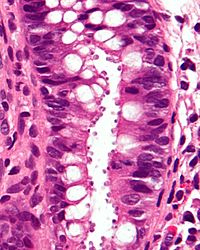
Photo from wikipedia
Leucocytozoonosis is a vector-borne infection of birds, caused by members of the haemosporidian genus Leucocytozoon. The clinical presentation may range from asymptomatic to severe disease. Consequences of Leucocytozoon infection on… Click to show full abstract
Leucocytozoonosis is a vector-borne infection of birds, caused by members of the haemosporidian genus Leucocytozoon. The clinical presentation may range from asymptomatic to severe disease. Consequences of Leucocytozoon infection on blood profiles remain to be described, especially for different host species in the wild. In the current study, the prevalence of Leucocytozoon infection was determined in wild nestlings of three European raptor species, the common buzzard (Buteo buteo, n = 464), red kite (Milvus milvus, n = 46) and northern goshawk (Accipiter gentilis, n = 18). Among 528 nestlings, 51.9% (n = 274) were infected with Leucocytozoon spp., whereby the highest prevalence was found in common buzzards (54.9%), followed by red kites (32.6%) and northern goshawks (22.2%). For a subset of 87 individuals (50 common buzzards, 29 red kites, 8 northern goshawks), a detailed analysis of differential leukocyte counts and several blood chemistry parameters in response to infection was conducted: AP (alkaline phosphatase), AST (aspartate aminotransferase), GLDH (glutamate dehydrogenase), LDH (lactate dehydrogenase), GGT (gamma glutamyl transferase), CK (creatine kinase), BuChE (butyrylcholinesterase), BA (bile acids), ALB (albumin) and TP (total protein). Even though in the physiological range, infected nestlings displayed significantly increased levels of heterophils, aspartate aminotransferase, lactate dehydrogenase, bile acids and butyrylcholinesterase, but decreased lymphocyte and monocyte values compared to uninfected ones. Furthermore, significant species differences with regard to blood parameters, but no sex differences were found. Overall, obtained results show a high prevalence, but a low pathogenicity of Leucocytozoon spp. in wild raptor chicks, presumably resulting from coevolutionary adaptation, but show signatures of infection in the haematological and blood chemistry profiles.
Journal Title: International Journal for Parasitology: Parasites and Wildlife
Year Published: 2021
Link to full text (if available)
Share on Social Media: Sign Up to like & get
recommendations!